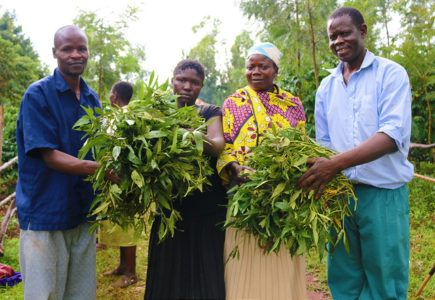Orange-fleshed sweetpotato (OFSP) is an excellent source of beta-carotene, which becomes vitamin A in the body. The crop can thus be a lifesaver for children during their first 1000 days, when vitamin A is essential for the development of good eyesight and good health. Vitamin A is also vital for breastfeeding mothers or women in their late pregnancy.
In an effort to reduce vitamin A deficiency in vulnerable households in sub-Sahara Africa, the International Potato Center (CIP) and partners distributed OFSP planting material to mothers and provided them with nutrition education and agronomic training. The aim was to convince and enable smallholder farmers to grow and consume OFSP, and thereby reduce the prevalence of vitamin A deficiency. But those farmers need to maintain their own planting material for subsequent growing seasons if their families are going to enjoy the health benefits of OFSP in the long term. And they did.

A recently published study by CIP researchers conducted in western Kenya, which sought to determine the effectiveness of this approach, found that farmers who received OFSP vines were likely to retain the crop and share it with others. The researchers determined that the retention rate was quite high, even when households received only 100–200 vines to plant. They also found that early adoption and diffusion was strongly influenced by information received by households and the channels used to disseminate it (agriculture-nutrition education and extension).
The researchers used quantitative methods, specifically regression analysis, to isolate the factors that influence early adoption and farmer-to-farmer diffusion and their causal effects, after determining retention rates. The study also explored the number of vines required per household for successful bulking for subsequent seasons. On average, 76% of households who received 100–200 vines of the VITAA and Kabode OFSP varieties in 2014 still had and planted one of those varieties a year later. A slightly lower proportion (62%) continued to plant both varieties of OFSP. Both cases refer to the short rain season of 2014.
Retention rates were significantly lower during the long rain season (32% for both and 36% or one) indicating a strong seasonality effect on retention rate. With respect to farmer-to-farmer sharing, the team found that 25% of farmers who received OFSP vines from the project shared them with their neighbors over the 1-2-year period.
Among the key factors determining early adoption were distance to a health facility (a source of nutrition education and counseling), listening to radio programs about OFSP, participation in project-convened field days, living near a community health volunteer (CHV), and having a plot of land in the lowlands. In the case of early farmer-to-farmer diffusion, factors such as education level, participation in mother-to-mother club meetings, living near a CHV and having plot of land in the lowlands were key drivers.

The study was conducted in 2016 and focused on households who received OFSP vines for planting in 2014 and 2015 under the Scaling Up Sweetpotato through Agriculture and Nutrition (SUSTAIN) project. In addition to OFSP planting material, those households went through intensive training in sweetpotato agronomy; maternal, infant and young child feeding practices and nutrition; and demonstrations of diversified utilization of sweetpotato.
SUSTAIN’s first phase (2013-2018) aimed to scale up the nutrition benefits of biofortified OFSP to smallholder farming households with children under five years in target countries. The project, funded by UKAid, supported an integrated set of interventions in agriculture, nutrition and marketing to increase production and consumption of OFSP. By the end of its first phase (by June 2018), the project had surpassed its initial target of 1.2 million farming households in five countries growing and consuming the pro vitamin A rich OFSP by over 40 percent.
Download this paper:
Blog written by Julius Okello and edited by Vivian Atakos and James Stapleton.
